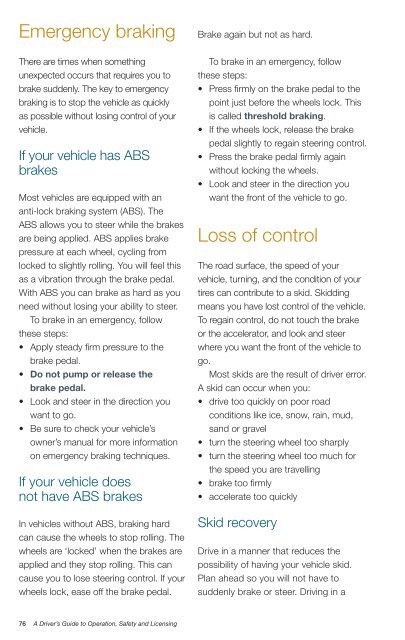DRIVER’S GUIDE
1POl7Ob
1POl7Ob
You also want an ePaper? Increase the reach of your titles
YUMPU automatically turns print PDFs into web optimized ePapers that Google loves.
Emergency braking<br />
There are times when something<br />
unexpected occurs that requires you to<br />
brake suddenly. The key to emergency<br />
braking is to stop the vehicle as quickly<br />
as possible without losing control of your<br />
vehicle.<br />
If your vehicle has ABS<br />
brakes<br />
Most vehicles are equipped with an<br />
anti-lock braking system (ABS). The<br />
ABS allows you to steer while the brakes<br />
are being applied. ABS applies brake<br />
pressure at each wheel, cycling from<br />
locked to slightly rolling. You will feel this<br />
as a vibration through the brake pedal.<br />
With ABS you can brake as hard as you<br />
need without losing your ability to steer.<br />
To brake in an emergency, follow<br />
these steps:<br />
• Apply steady firm pressure to the<br />
brake pedal.<br />
• Do not pump or release the<br />
brake pedal.<br />
• Look and steer in the direction you<br />
want to go.<br />
• Be sure to check your vehicle’s<br />
owner’s manual for more information<br />
on emergency braking techniques.<br />
If your vehicle does<br />
not have ABS brakes<br />
In vehicles without ABS, braking hard<br />
can cause the wheels to stop rolling. The<br />
wheels are ‘locked’ when the brakes are<br />
applied and they stop rolling. This can<br />
cause you to lose steering control. If your<br />
wheels lock, ease off the brake pedal.<br />
Brake again but not as hard.<br />
To brake in an emergency, follow<br />
these steps:<br />
• Press firmly on the brake pedal to the<br />
point just before the wheels lock. This<br />
is called threshold braking.<br />
• If the wheels lock, release the brake<br />
pedal slightly to regain steering control.<br />
• Press the brake pedal firmly again<br />
without locking the wheels.<br />
• Look and steer in the direction you<br />
want the front of the vehicle to go.<br />
Loss of control<br />
The road surface, the speed of your<br />
vehicle, turning, and the condition of your<br />
tires can contribute to a skid. Skidding<br />
means you have lost control of the vehicle.<br />
To regain control, do not touch the brake<br />
or the accelerator, and look and steer<br />
where you want the front of the vehicle to<br />
go.<br />
Most skids are the result of driver error.<br />
A skid can occur when you:<br />
• drive too quickly on poor road<br />
conditions like ice, snow, rain, mud,<br />
sand or gravel<br />
• turn the steering wheel too sharply<br />
• turn the steering wheel too much for<br />
the speed you are travelling<br />
• brake too firmly<br />
• accelerate too quickly<br />
Skid recovery<br />
Drive in a manner that reduces the<br />
possibility of having your vehicle skid.<br />
Plan ahead so you will not have to<br />
suddenly brake or steer. Driving in a<br />
76 A Driver’s Guide to Operation, Safety and Licensing


